Hospitality Business Strategy
VerifiedAdded on 2023/01/10
|15
|4237
|83
AI Summary
This report explores the business strategy in the hospitality industry, with a focus on Marriott International. It includes a PESTEL and SWOT analysis, Porter's Five Forces Model, and different strategic directions for growth. The report also provides recommendations for the most appropriate growth platform and strategies.
Contribute Materials
Your contribution can guide someone’s learning journey. Share your
documents today.

Hospitality Business
Strategy
Strategy
Secure Best Marks with AI Grader
Need help grading? Try our AI Grader for instant feedback on your assignments.
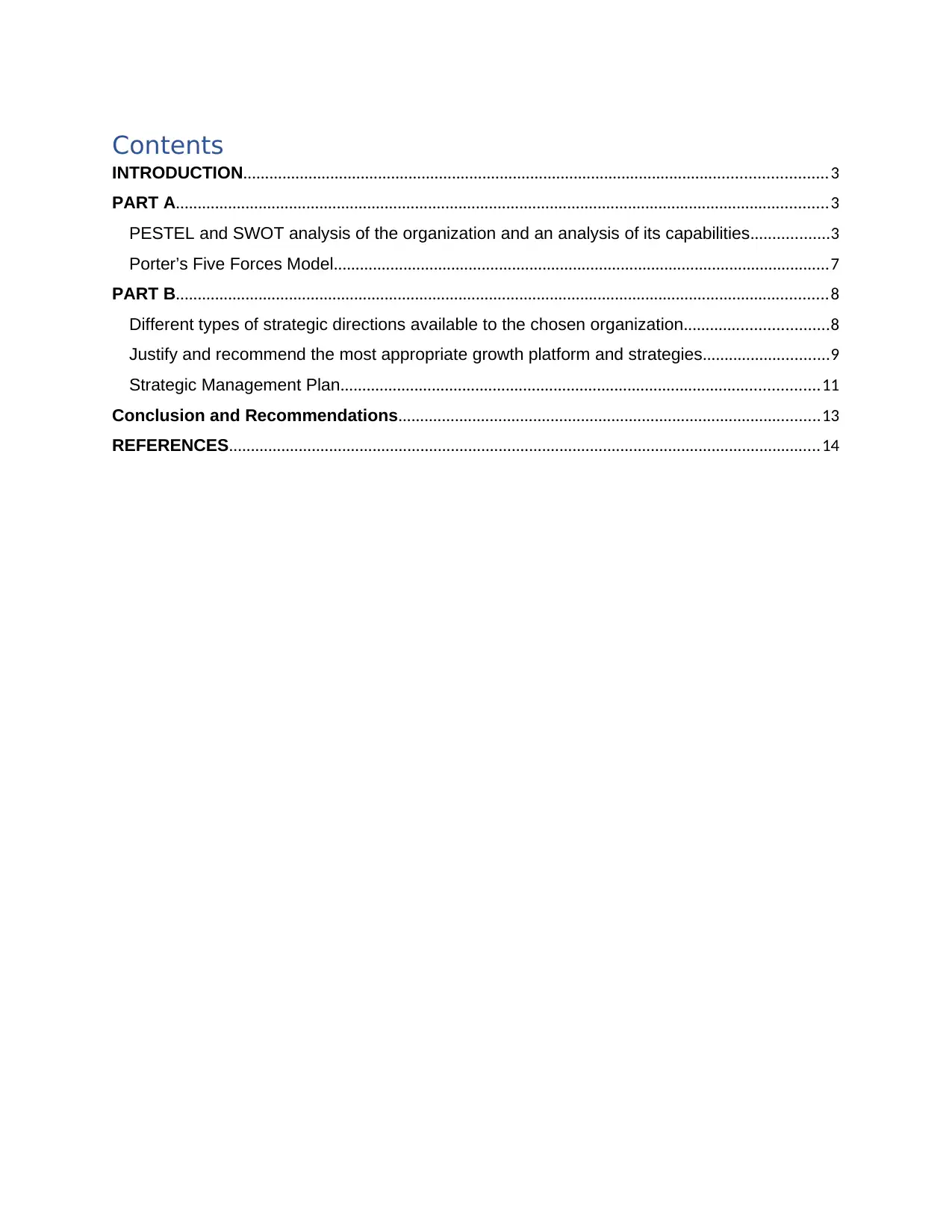
Contents
INTRODUCTION......................................................................................................................................3
PART A......................................................................................................................................................3
PESTEL and SWOT analysis of the organization and an analysis of its capabilities..................3
Porter’s Five Forces Model..................................................................................................................7
PART B......................................................................................................................................................8
Different types of strategic directions available to the chosen organization.................................8
Justify and recommend the most appropriate growth platform and strategies.............................9
Strategic Management Plan..............................................................................................................11
Conclusion and Recommendations.................................................................................................13
REFERENCES........................................................................................................................................14
INTRODUCTION......................................................................................................................................3
PART A......................................................................................................................................................3
PESTEL and SWOT analysis of the organization and an analysis of its capabilities..................3
Porter’s Five Forces Model..................................................................................................................7
PART B......................................................................................................................................................8
Different types of strategic directions available to the chosen organization.................................8
Justify and recommend the most appropriate growth platform and strategies.............................9
Strategic Management Plan..............................................................................................................11
Conclusion and Recommendations.................................................................................................13
REFERENCES........................................................................................................................................14
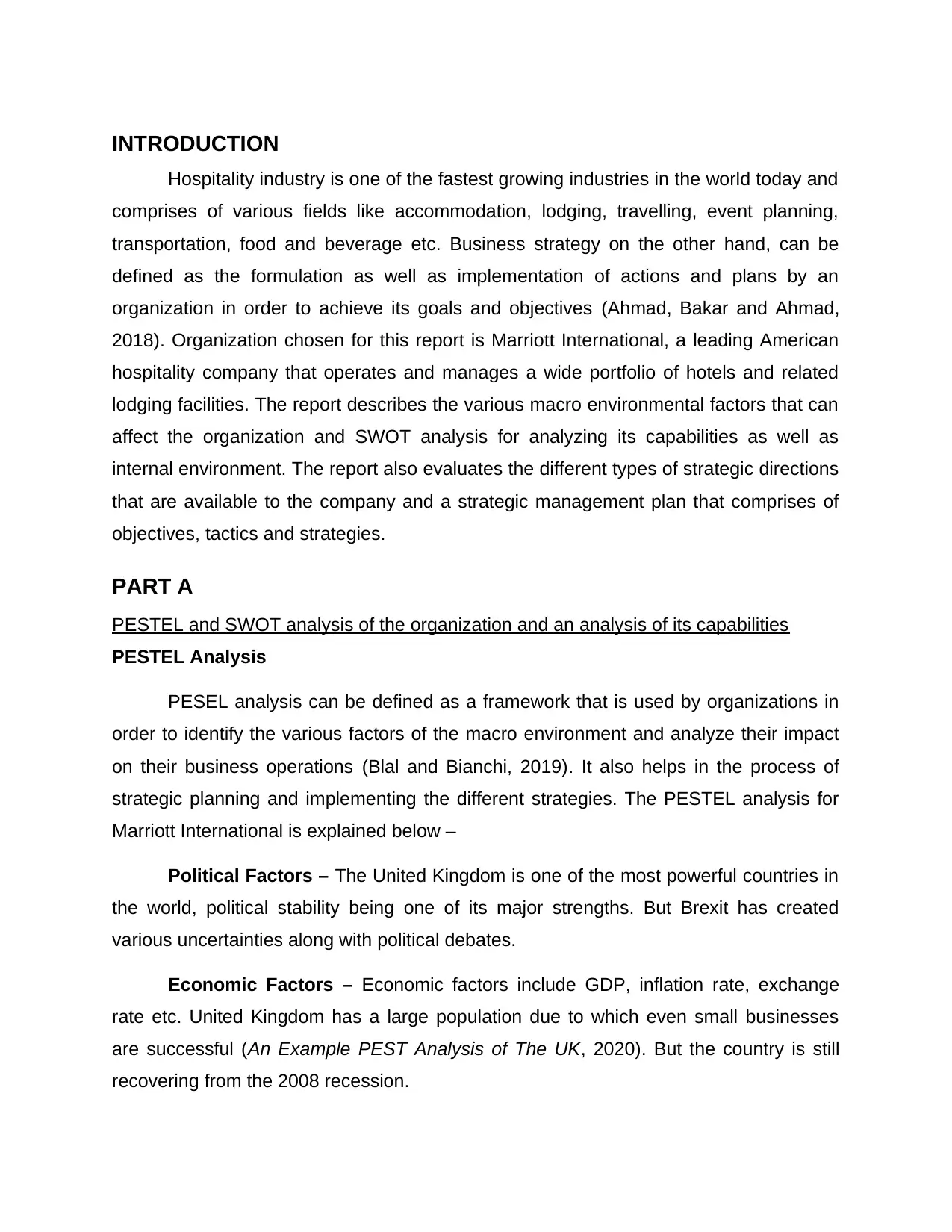
INTRODUCTION
Hospitality industry is one of the fastest growing industries in the world today and
comprises of various fields like accommodation, lodging, travelling, event planning,
transportation, food and beverage etc. Business strategy on the other hand, can be
defined as the formulation as well as implementation of actions and plans by an
organization in order to achieve its goals and objectives (Ahmad, Bakar and Ahmad,
2018). Organization chosen for this report is Marriott International, a leading American
hospitality company that operates and manages a wide portfolio of hotels and related
lodging facilities. The report describes the various macro environmental factors that can
affect the organization and SWOT analysis for analyzing its capabilities as well as
internal environment. The report also evaluates the different types of strategic directions
that are available to the company and a strategic management plan that comprises of
objectives, tactics and strategies.
PART A
PESTEL and SWOT analysis of the organization and an analysis of its capabilities
PESTEL Analysis
PESEL analysis can be defined as a framework that is used by organizations in
order to identify the various factors of the macro environment and analyze their impact
on their business operations (Blal and Bianchi, 2019). It also helps in the process of
strategic planning and implementing the different strategies. The PESTEL analysis for
Marriott International is explained below –
Political Factors – The United Kingdom is one of the most powerful countries in
the world, political stability being one of its major strengths. But Brexit has created
various uncertainties along with political debates.
Economic Factors – Economic factors include GDP, inflation rate, exchange
rate etc. United Kingdom has a large population due to which even small businesses
are successful (An Example PEST Analysis of The UK, 2020). But the country is still
recovering from the 2008 recession.
Hospitality industry is one of the fastest growing industries in the world today and
comprises of various fields like accommodation, lodging, travelling, event planning,
transportation, food and beverage etc. Business strategy on the other hand, can be
defined as the formulation as well as implementation of actions and plans by an
organization in order to achieve its goals and objectives (Ahmad, Bakar and Ahmad,
2018). Organization chosen for this report is Marriott International, a leading American
hospitality company that operates and manages a wide portfolio of hotels and related
lodging facilities. The report describes the various macro environmental factors that can
affect the organization and SWOT analysis for analyzing its capabilities as well as
internal environment. The report also evaluates the different types of strategic directions
that are available to the company and a strategic management plan that comprises of
objectives, tactics and strategies.
PART A
PESTEL and SWOT analysis of the organization and an analysis of its capabilities
PESTEL Analysis
PESEL analysis can be defined as a framework that is used by organizations in
order to identify the various factors of the macro environment and analyze their impact
on their business operations (Blal and Bianchi, 2019). It also helps in the process of
strategic planning and implementing the different strategies. The PESTEL analysis for
Marriott International is explained below –
Political Factors – The United Kingdom is one of the most powerful countries in
the world, political stability being one of its major strengths. But Brexit has created
various uncertainties along with political debates.
Economic Factors – Economic factors include GDP, inflation rate, exchange
rate etc. United Kingdom has a large population due to which even small businesses
are successful (An Example PEST Analysis of The UK, 2020). But the country is still
recovering from the 2008 recession.
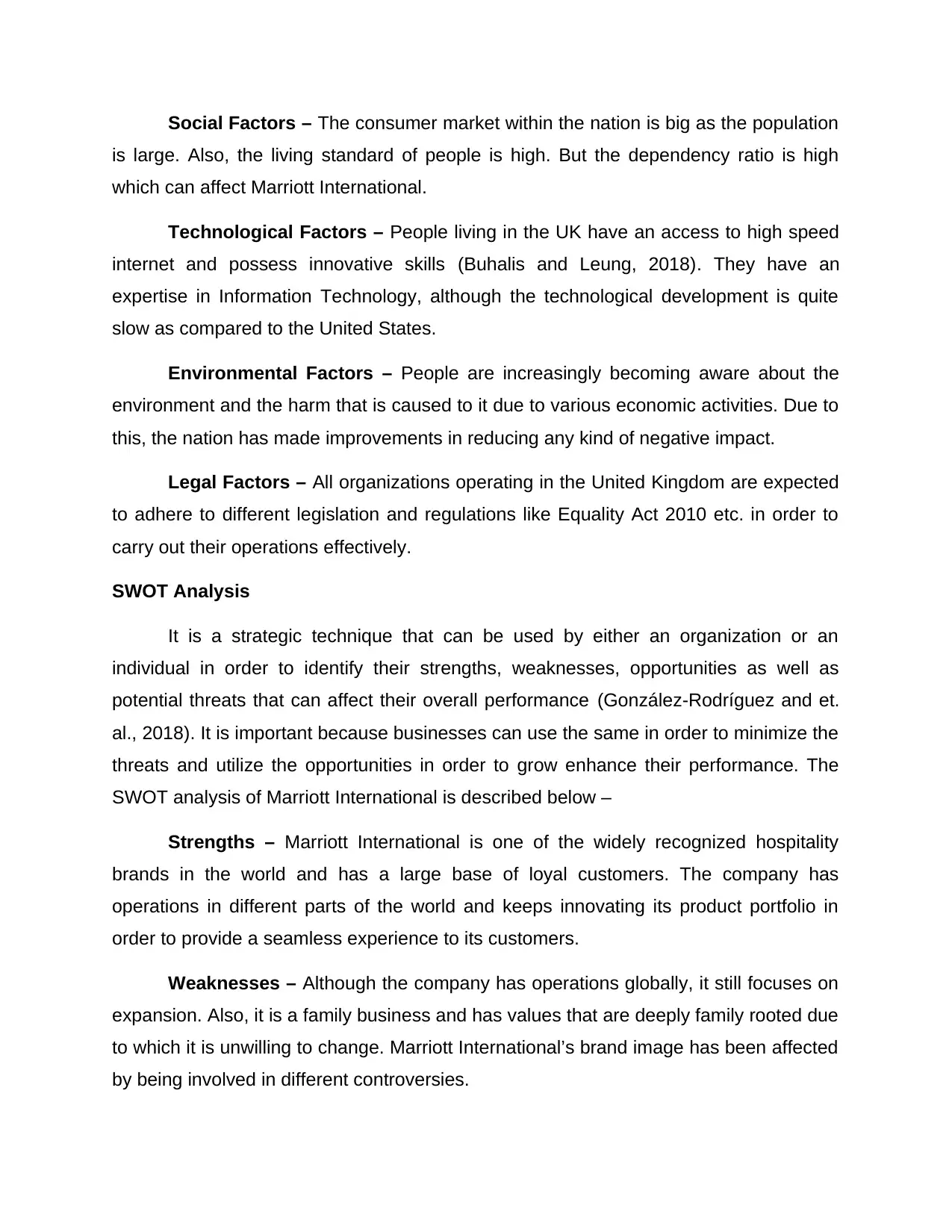
Social Factors – The consumer market within the nation is big as the population
is large. Also, the living standard of people is high. But the dependency ratio is high
which can affect Marriott International.
Technological Factors – People living in the UK have an access to high speed
internet and possess innovative skills (Buhalis and Leung, 2018). They have an
expertise in Information Technology, although the technological development is quite
slow as compared to the United States.
Environmental Factors – People are increasingly becoming aware about the
environment and the harm that is caused to it due to various economic activities. Due to
this, the nation has made improvements in reducing any kind of negative impact.
Legal Factors – All organizations operating in the United Kingdom are expected
to adhere to different legislation and regulations like Equality Act 2010 etc. in order to
carry out their operations effectively.
SWOT Analysis
It is a strategic technique that can be used by either an organization or an
individual in order to identify their strengths, weaknesses, opportunities as well as
potential threats that can affect their overall performance (González-Rodríguez and et.
al., 2018). It is important because businesses can use the same in order to minimize the
threats and utilize the opportunities in order to grow enhance their performance. The
SWOT analysis of Marriott International is described below –
Strengths – Marriott International is one of the widely recognized hospitality
brands in the world and has a large base of loyal customers. The company has
operations in different parts of the world and keeps innovating its product portfolio in
order to provide a seamless experience to its customers.
Weaknesses – Although the company has operations globally, it still focuses on
expansion. Also, it is a family business and has values that are deeply family rooted due
to which it is unwilling to change. Marriott International’s brand image has been affected
by being involved in different controversies.
is large. Also, the living standard of people is high. But the dependency ratio is high
which can affect Marriott International.
Technological Factors – People living in the UK have an access to high speed
internet and possess innovative skills (Buhalis and Leung, 2018). They have an
expertise in Information Technology, although the technological development is quite
slow as compared to the United States.
Environmental Factors – People are increasingly becoming aware about the
environment and the harm that is caused to it due to various economic activities. Due to
this, the nation has made improvements in reducing any kind of negative impact.
Legal Factors – All organizations operating in the United Kingdom are expected
to adhere to different legislation and regulations like Equality Act 2010 etc. in order to
carry out their operations effectively.
SWOT Analysis
It is a strategic technique that can be used by either an organization or an
individual in order to identify their strengths, weaknesses, opportunities as well as
potential threats that can affect their overall performance (González-Rodríguez and et.
al., 2018). It is important because businesses can use the same in order to minimize the
threats and utilize the opportunities in order to grow enhance their performance. The
SWOT analysis of Marriott International is described below –
Strengths – Marriott International is one of the widely recognized hospitality
brands in the world and has a large base of loyal customers. The company has
operations in different parts of the world and keeps innovating its product portfolio in
order to provide a seamless experience to its customers.
Weaknesses – Although the company has operations globally, it still focuses on
expansion. Also, it is a family business and has values that are deeply family rooted due
to which it is unwilling to change. Marriott International’s brand image has been affected
by being involved in different controversies.
Secure Best Marks with AI Grader
Need help grading? Try our AI Grader for instant feedback on your assignments.

Opportunities – The hospitality industry is growing rapidly and although the
respective company has a wide presence, it can implement the latest technology in
order to increase its share in the market (Han, Lee and Kim, 2018). It can also build
strategic alliances with other brands to cater the needs of customers effectively.
Threats – Increasing competition can pose as a threat to Marriott International
and can affect its overall performance and position in the market. Failure to implement
the latest technology in its system can also act as a threat. Apart from this, the prices of
raw material are also rising.
VRIO Analysis
Resources Valuable Rare Inimitable Organized
Financial Sources ✓
Products ✓ ✓
Distribution Network ✓ ✓ ✓
Employees ✓ ✓ ✓ ✓
Valuable
Resources are considered to be valuable if they help in increasing the perceived
value of an organization among customers. This is usually done by increasing
the differentiation or reducing the prices of products.
Financial sources are highly valuable for Marriott International because they help
it in investing into various external opportunities and thus expand its business
(Hwang and Lee, 2019). On the other hand, products also, are valuable because
they are highly differentiated in comparison to its competitors and re thus, valued
more by the customers.
Distribution Network is valuable for the company because it helps in reaching out
a large number of customers. This further ensures that the company generates
greater revenues and that its different promotional activities get converted into
sales.
respective company has a wide presence, it can implement the latest technology in
order to increase its share in the market (Han, Lee and Kim, 2018). It can also build
strategic alliances with other brands to cater the needs of customers effectively.
Threats – Increasing competition can pose as a threat to Marriott International
and can affect its overall performance and position in the market. Failure to implement
the latest technology in its system can also act as a threat. Apart from this, the prices of
raw material are also rising.
VRIO Analysis
Resources Valuable Rare Inimitable Organized
Financial Sources ✓
Products ✓ ✓
Distribution Network ✓ ✓ ✓
Employees ✓ ✓ ✓ ✓
Valuable
Resources are considered to be valuable if they help in increasing the perceived
value of an organization among customers. This is usually done by increasing
the differentiation or reducing the prices of products.
Financial sources are highly valuable for Marriott International because they help
it in investing into various external opportunities and thus expand its business
(Hwang and Lee, 2019). On the other hand, products also, are valuable because
they are highly differentiated in comparison to its competitors and re thus, valued
more by the customers.
Distribution Network is valuable for the company because it helps in reaching out
a large number of customers. This further ensures that the company generates
greater revenues and that its different promotional activities get converted into
sales.
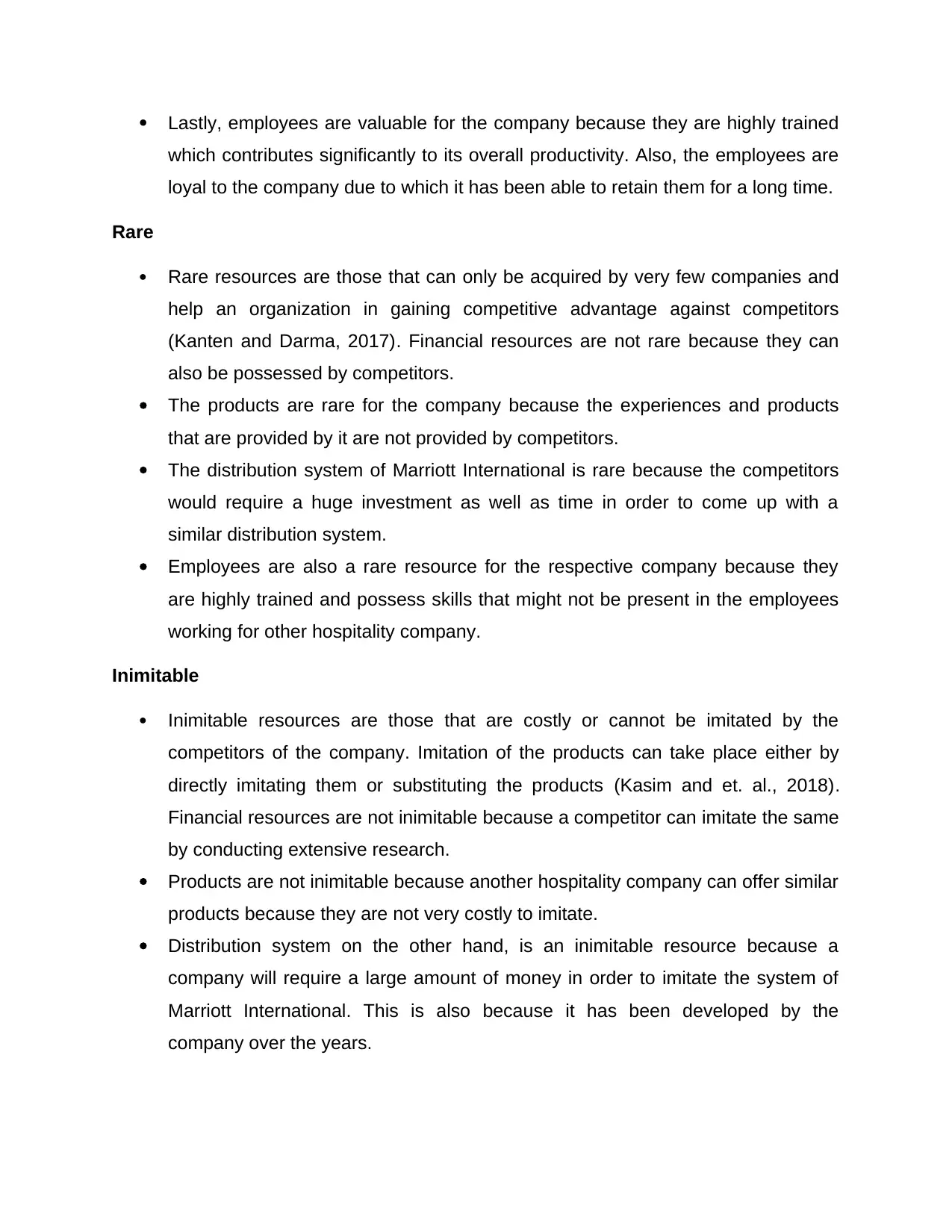
Lastly, employees are valuable for the company because they are highly trained
which contributes significantly to its overall productivity. Also, the employees are
loyal to the company due to which it has been able to retain them for a long time.
Rare
Rare resources are those that can only be acquired by very few companies and
help an organization in gaining competitive advantage against competitors
(Kanten and Darma, 2017). Financial resources are not rare because they can
also be possessed by competitors.
The products are rare for the company because the experiences and products
that are provided by it are not provided by competitors.
The distribution system of Marriott International is rare because the competitors
would require a huge investment as well as time in order to come up with a
similar distribution system.
Employees are also a rare resource for the respective company because they
are highly trained and possess skills that might not be present in the employees
working for other hospitality company.
Inimitable
Inimitable resources are those that are costly or cannot be imitated by the
competitors of the company. Imitation of the products can take place either by
directly imitating them or substituting the products (Kasim and et. al., 2018).
Financial resources are not inimitable because a competitor can imitate the same
by conducting extensive research.
Products are not inimitable because another hospitality company can offer similar
products because they are not very costly to imitate.
Distribution system on the other hand, is an inimitable resource because a
company will require a large amount of money in order to imitate the system of
Marriott International. This is also because it has been developed by the
company over the years.
which contributes significantly to its overall productivity. Also, the employees are
loyal to the company due to which it has been able to retain them for a long time.
Rare
Rare resources are those that can only be acquired by very few companies and
help an organization in gaining competitive advantage against competitors
(Kanten and Darma, 2017). Financial resources are not rare because they can
also be possessed by competitors.
The products are rare for the company because the experiences and products
that are provided by it are not provided by competitors.
The distribution system of Marriott International is rare because the competitors
would require a huge investment as well as time in order to come up with a
similar distribution system.
Employees are also a rare resource for the respective company because they
are highly trained and possess skills that might not be present in the employees
working for other hospitality company.
Inimitable
Inimitable resources are those that are costly or cannot be imitated by the
competitors of the company. Imitation of the products can take place either by
directly imitating them or substituting the products (Kasim and et. al., 2018).
Financial resources are not inimitable because a competitor can imitate the same
by conducting extensive research.
Products are not inimitable because another hospitality company can offer similar
products because they are not very costly to imitate.
Distribution system on the other hand, is an inimitable resource because a
company will require a large amount of money in order to imitate the system of
Marriott International. This is also because it has been developed by the
company over the years.
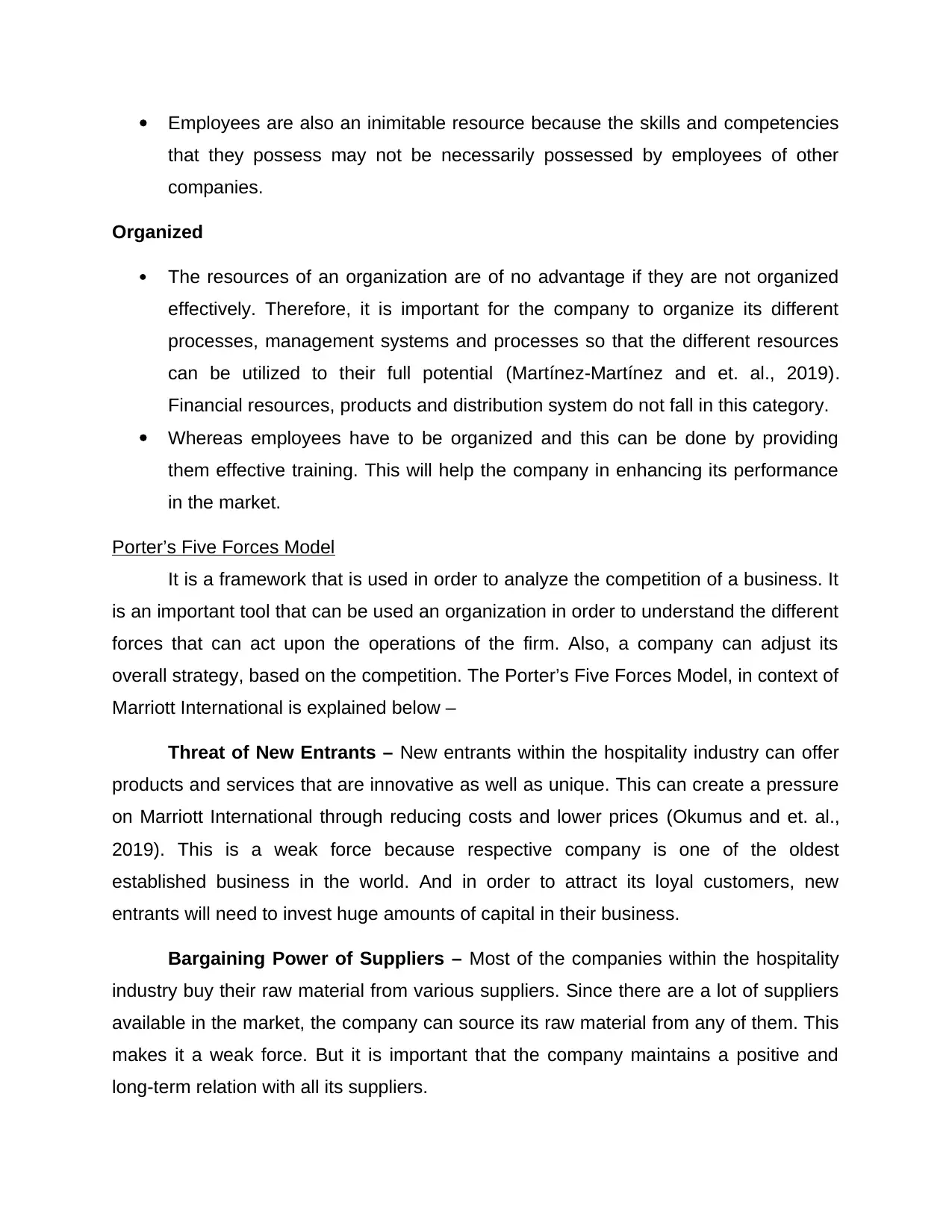
Employees are also an inimitable resource because the skills and competencies
that they possess may not be necessarily possessed by employees of other
companies.
Organized
The resources of an organization are of no advantage if they are not organized
effectively. Therefore, it is important for the company to organize its different
processes, management systems and processes so that the different resources
can be utilized to their full potential (Martínez-Martínez and et. al., 2019).
Financial resources, products and distribution system do not fall in this category.
Whereas employees have to be organized and this can be done by providing
them effective training. This will help the company in enhancing its performance
in the market.
Porter’s Five Forces Model
It is a framework that is used in order to analyze the competition of a business. It
is an important tool that can be used an organization in order to understand the different
forces that can act upon the operations of the firm. Also, a company can adjust its
overall strategy, based on the competition. The Porter’s Five Forces Model, in context of
Marriott International is explained below –
Threat of New Entrants – New entrants within the hospitality industry can offer
products and services that are innovative as well as unique. This can create a pressure
on Marriott International through reducing costs and lower prices (Okumus and et. al.,
2019). This is a weak force because respective company is one of the oldest
established business in the world. And in order to attract its loyal customers, new
entrants will need to invest huge amounts of capital in their business.
Bargaining Power of Suppliers – Most of the companies within the hospitality
industry buy their raw material from various suppliers. Since there are a lot of suppliers
available in the market, the company can source its raw material from any of them. This
makes it a weak force. But it is important that the company maintains a positive and
long-term relation with all its suppliers.
that they possess may not be necessarily possessed by employees of other
companies.
Organized
The resources of an organization are of no advantage if they are not organized
effectively. Therefore, it is important for the company to organize its different
processes, management systems and processes so that the different resources
can be utilized to their full potential (Martínez-Martínez and et. al., 2019).
Financial resources, products and distribution system do not fall in this category.
Whereas employees have to be organized and this can be done by providing
them effective training. This will help the company in enhancing its performance
in the market.
Porter’s Five Forces Model
It is a framework that is used in order to analyze the competition of a business. It
is an important tool that can be used an organization in order to understand the different
forces that can act upon the operations of the firm. Also, a company can adjust its
overall strategy, based on the competition. The Porter’s Five Forces Model, in context of
Marriott International is explained below –
Threat of New Entrants – New entrants within the hospitality industry can offer
products and services that are innovative as well as unique. This can create a pressure
on Marriott International through reducing costs and lower prices (Okumus and et. al.,
2019). This is a weak force because respective company is one of the oldest
established business in the world. And in order to attract its loyal customers, new
entrants will need to invest huge amounts of capital in their business.
Bargaining Power of Suppliers – Most of the companies within the hospitality
industry buy their raw material from various suppliers. Since there are a lot of suppliers
available in the market, the company can source its raw material from any of them. This
makes it a weak force. But it is important that the company maintains a positive and
long-term relation with all its suppliers.
Paraphrase This Document
Need a fresh take? Get an instant paraphrase of this document with our AI Paraphraser
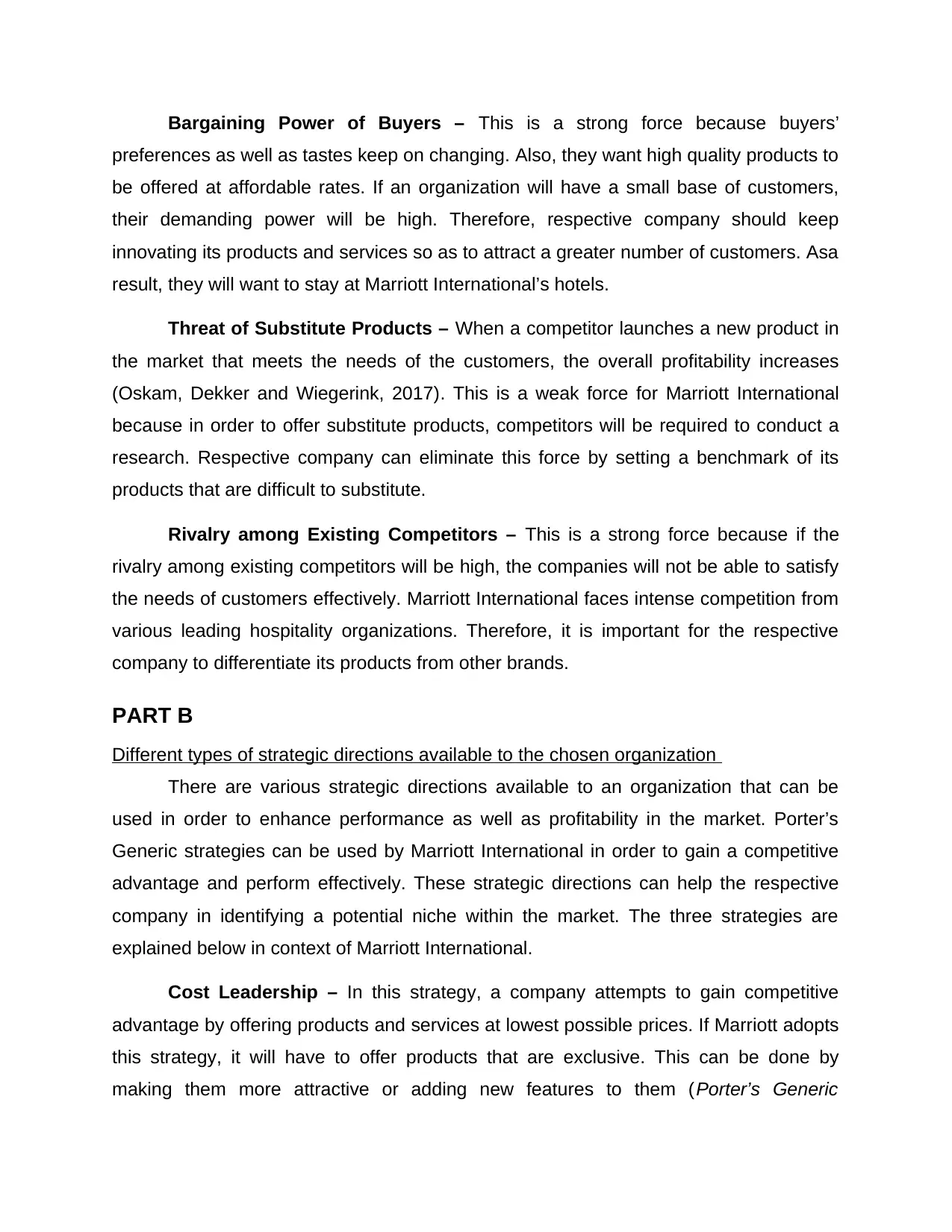
Bargaining Power of Buyers – This is a strong force because buyers’
preferences as well as tastes keep on changing. Also, they want high quality products to
be offered at affordable rates. If an organization will have a small base of customers,
their demanding power will be high. Therefore, respective company should keep
innovating its products and services so as to attract a greater number of customers. Asa
result, they will want to stay at Marriott International’s hotels.
Threat of Substitute Products – When a competitor launches a new product in
the market that meets the needs of the customers, the overall profitability increases
(Oskam, Dekker and Wiegerink, 2017). This is a weak force for Marriott International
because in order to offer substitute products, competitors will be required to conduct a
research. Respective company can eliminate this force by setting a benchmark of its
products that are difficult to substitute.
Rivalry among Existing Competitors – This is a strong force because if the
rivalry among existing competitors will be high, the companies will not be able to satisfy
the needs of customers effectively. Marriott International faces intense competition from
various leading hospitality organizations. Therefore, it is important for the respective
company to differentiate its products from other brands.
PART B
Different types of strategic directions available to the chosen organization
There are various strategic directions available to an organization that can be
used in order to enhance performance as well as profitability in the market. Porter’s
Generic strategies can be used by Marriott International in order to gain a competitive
advantage and perform effectively. These strategic directions can help the respective
company in identifying a potential niche within the market. The three strategies are
explained below in context of Marriott International.
Cost Leadership – In this strategy, a company attempts to gain competitive
advantage by offering products and services at lowest possible prices. If Marriott adopts
this strategy, it will have to offer products that are exclusive. This can be done by
making them more attractive or adding new features to them (Porter’s Generic
preferences as well as tastes keep on changing. Also, they want high quality products to
be offered at affordable rates. If an organization will have a small base of customers,
their demanding power will be high. Therefore, respective company should keep
innovating its products and services so as to attract a greater number of customers. Asa
result, they will want to stay at Marriott International’s hotels.
Threat of Substitute Products – When a competitor launches a new product in
the market that meets the needs of the customers, the overall profitability increases
(Oskam, Dekker and Wiegerink, 2017). This is a weak force for Marriott International
because in order to offer substitute products, competitors will be required to conduct a
research. Respective company can eliminate this force by setting a benchmark of its
products that are difficult to substitute.
Rivalry among Existing Competitors – This is a strong force because if the
rivalry among existing competitors will be high, the companies will not be able to satisfy
the needs of customers effectively. Marriott International faces intense competition from
various leading hospitality organizations. Therefore, it is important for the respective
company to differentiate its products from other brands.
PART B
Different types of strategic directions available to the chosen organization
There are various strategic directions available to an organization that can be
used in order to enhance performance as well as profitability in the market. Porter’s
Generic strategies can be used by Marriott International in order to gain a competitive
advantage and perform effectively. These strategic directions can help the respective
company in identifying a potential niche within the market. The three strategies are
explained below in context of Marriott International.
Cost Leadership – In this strategy, a company attempts to gain competitive
advantage by offering products and services at lowest possible prices. If Marriott adopts
this strategy, it will have to offer products that are exclusive. This can be done by
making them more attractive or adding new features to them (Porter’s Generic

Strategies, 2020). Organizations that choose to apply this strategy have considerable
investment capital with them. Low cost producers usually find and try to exploit all
sources of cost advantage. Also, such organizations mainly focus on their internal
processes because the major aim is to keep the costs of products as low as possible. A
cost leadership strategy can also involve increasing the market share by charging low
costs for the products.
Differentiation – In the differentiation strategy, a company tries to differentiate
itself from the competitors (Peters and Kallmuenzer, 2018). This is usually done by
identifying the attributes that most buyers in the industry consider to be important and
positioning the company in such a way so that the needs of customers are met. If
Marriott International wants to be successful in implementing this strategy, it will have to
conduct an extensive research as well as an ability to provide products that are unique.
Also, in this strategy, it is important for the company to market its products effectively.
These types of organizations have a creative approach so that a greater number of
customers are attracted. This contributes to the overall profitability of the firm.
Focus – Organizations that use focus strategy, focus on specific niche markets
as well as the unique needs of customers. Also, because such companies serve the
needs of their customers so well, the customers ten to become very loyal to them. Due
to this, a particular segment in the market becomes less attractive to the competitors.
The target segments in this have customers who have unusual needs. Focus strategy
helps the company not only in understanding the needs of customers, but also
satisfying them effectively.
Therefore, Marriott International should implement differentiation strategy
because it will help the company in attracting a greater number of customers as well as
satisfy their needs (Prebensen, Chen and Uysal, 2018). Also, the company will be able
to gain a competitive advantage against competitors.
Justify and recommend the most appropriate growth platform and strategies
The Ansoff’s Matrix is a tool that helps managers as well as marketers in
formulating effective strategies for the future growth of the company. The framework
also informs the management within an organization about what strategies should be
investment capital with them. Low cost producers usually find and try to exploit all
sources of cost advantage. Also, such organizations mainly focus on their internal
processes because the major aim is to keep the costs of products as low as possible. A
cost leadership strategy can also involve increasing the market share by charging low
costs for the products.
Differentiation – In the differentiation strategy, a company tries to differentiate
itself from the competitors (Peters and Kallmuenzer, 2018). This is usually done by
identifying the attributes that most buyers in the industry consider to be important and
positioning the company in such a way so that the needs of customers are met. If
Marriott International wants to be successful in implementing this strategy, it will have to
conduct an extensive research as well as an ability to provide products that are unique.
Also, in this strategy, it is important for the company to market its products effectively.
These types of organizations have a creative approach so that a greater number of
customers are attracted. This contributes to the overall profitability of the firm.
Focus – Organizations that use focus strategy, focus on specific niche markets
as well as the unique needs of customers. Also, because such companies serve the
needs of their customers so well, the customers ten to become very loyal to them. Due
to this, a particular segment in the market becomes less attractive to the competitors.
The target segments in this have customers who have unusual needs. Focus strategy
helps the company not only in understanding the needs of customers, but also
satisfying them effectively.
Therefore, Marriott International should implement differentiation strategy
because it will help the company in attracting a greater number of customers as well as
satisfy their needs (Prebensen, Chen and Uysal, 2018). Also, the company will be able
to gain a competitive advantage against competitors.
Justify and recommend the most appropriate growth platform and strategies
The Ansoff’s Matrix is a tool that helps managers as well as marketers in
formulating effective strategies for the future growth of the company. The framework
also informs the management within an organization about what strategies should be
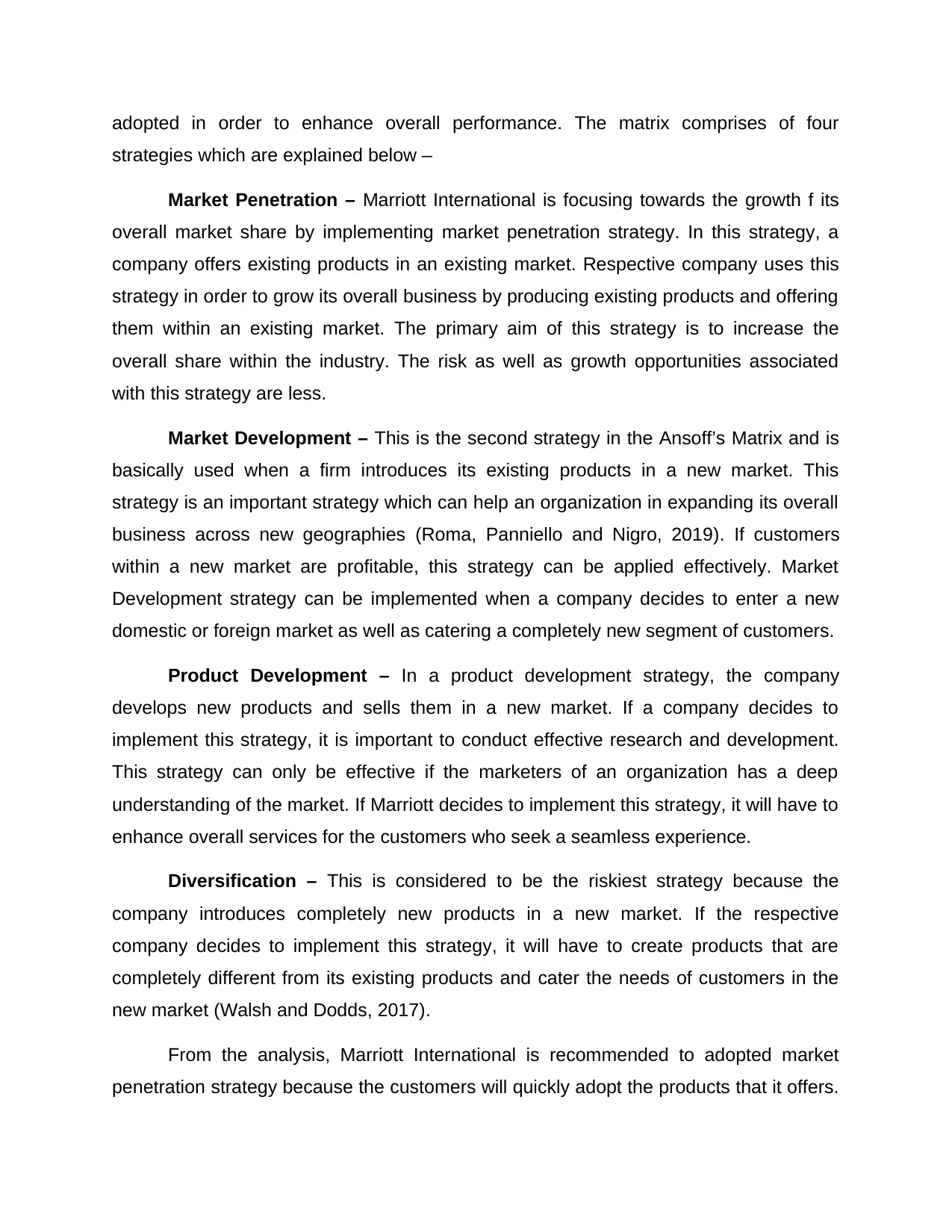
adopted in order to enhance overall performance. The matrix comprises of four
strategies which are explained below –
Market Penetration – Marriott International is focusing towards the growth f its
overall market share by implementing market penetration strategy. In this strategy, a
company offers existing products in an existing market. Respective company uses this
strategy in order to grow its overall business by producing existing products and offering
them within an existing market. The primary aim of this strategy is to increase the
overall share within the industry. The risk as well as growth opportunities associated
with this strategy are less.
Market Development – This is the second strategy in the Ansoff’s Matrix and is
basically used when a firm introduces its existing products in a new market. This
strategy is an important strategy which can help an organization in expanding its overall
business across new geographies (Roma, Panniello and Nigro, 2019). If customers
within a new market are profitable, this strategy can be applied effectively. Market
Development strategy can be implemented when a company decides to enter a new
domestic or foreign market as well as catering a completely new segment of customers.
Product Development – In a product development strategy, the company
develops new products and sells them in a new market. If a company decides to
implement this strategy, it is important to conduct effective research and development.
This strategy can only be effective if the marketers of an organization has a deep
understanding of the market. If Marriott decides to implement this strategy, it will have to
enhance overall services for the customers who seek a seamless experience.
Diversification – This is considered to be the riskiest strategy because the
company introduces completely new products in a new market. If the respective
company decides to implement this strategy, it will have to create products that are
completely different from its existing products and cater the needs of customers in the
new market (Walsh and Dodds, 2017).
From the analysis, Marriott International is recommended to adopted market
penetration strategy because the customers will quickly adopt the products that it offers.
strategies which are explained below –
Market Penetration – Marriott International is focusing towards the growth f its
overall market share by implementing market penetration strategy. In this strategy, a
company offers existing products in an existing market. Respective company uses this
strategy in order to grow its overall business by producing existing products and offering
them within an existing market. The primary aim of this strategy is to increase the
overall share within the industry. The risk as well as growth opportunities associated
with this strategy are less.
Market Development – This is the second strategy in the Ansoff’s Matrix and is
basically used when a firm introduces its existing products in a new market. This
strategy is an important strategy which can help an organization in expanding its overall
business across new geographies (Roma, Panniello and Nigro, 2019). If customers
within a new market are profitable, this strategy can be applied effectively. Market
Development strategy can be implemented when a company decides to enter a new
domestic or foreign market as well as catering a completely new segment of customers.
Product Development – In a product development strategy, the company
develops new products and sells them in a new market. If a company decides to
implement this strategy, it is important to conduct effective research and development.
This strategy can only be effective if the marketers of an organization has a deep
understanding of the market. If Marriott decides to implement this strategy, it will have to
enhance overall services for the customers who seek a seamless experience.
Diversification – This is considered to be the riskiest strategy because the
company introduces completely new products in a new market. If the respective
company decides to implement this strategy, it will have to create products that are
completely different from its existing products and cater the needs of customers in the
new market (Walsh and Dodds, 2017).
From the analysis, Marriott International is recommended to adopted market
penetration strategy because the customers will quickly adopt the products that it offers.
Secure Best Marks with AI Grader
Need help grading? Try our AI Grader for instant feedback on your assignments.
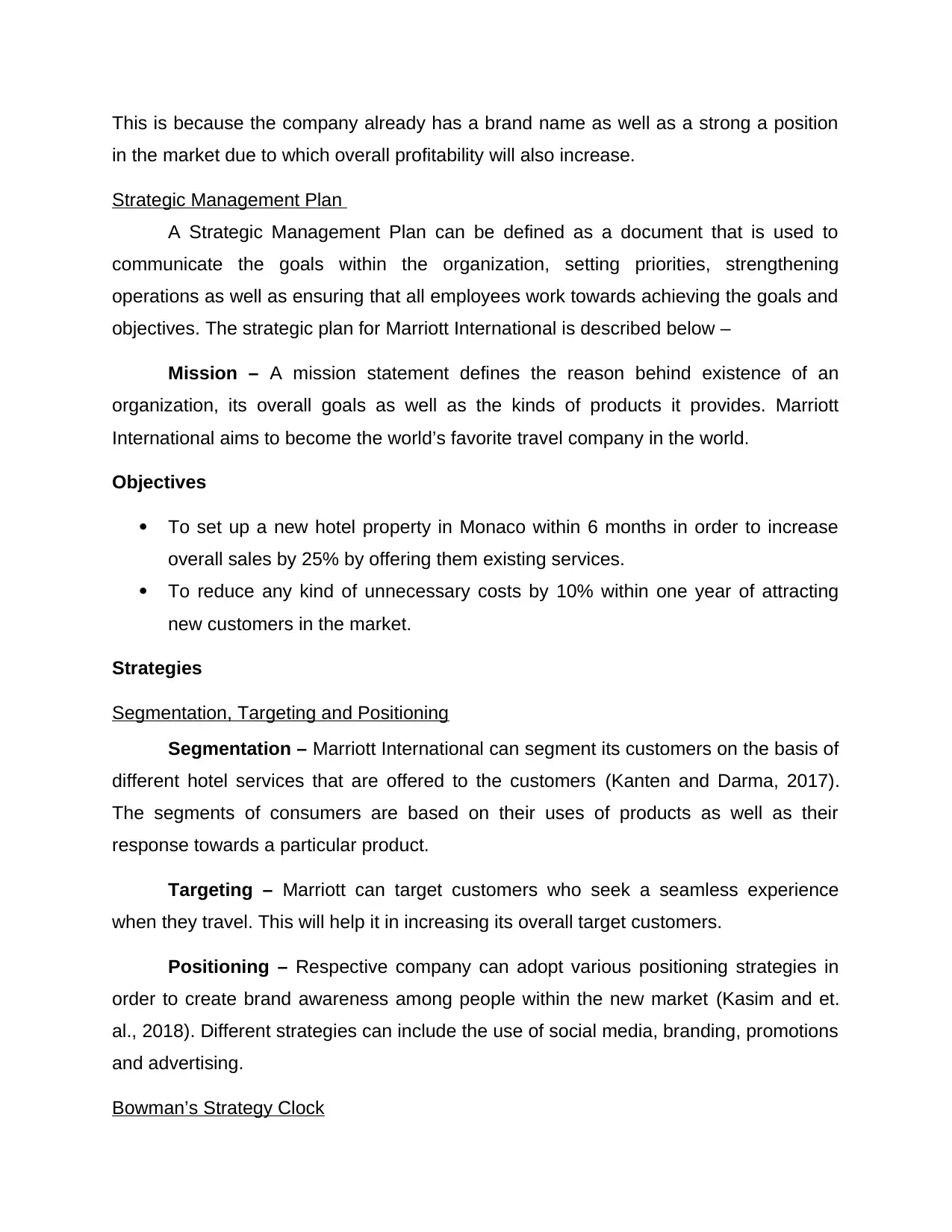
This is because the company already has a brand name as well as a strong a position
in the market due to which overall profitability will also increase.
Strategic Management Plan
A Strategic Management Plan can be defined as a document that is used to
communicate the goals within the organization, setting priorities, strengthening
operations as well as ensuring that all employees work towards achieving the goals and
objectives. The strategic plan for Marriott International is described below –
Mission – A mission statement defines the reason behind existence of an
organization, its overall goals as well as the kinds of products it provides. Marriott
International aims to become the world’s favorite travel company in the world.
Objectives
To set up a new hotel property in Monaco within 6 months in order to increase
overall sales by 25% by offering them existing services.
To reduce any kind of unnecessary costs by 10% within one year of attracting
new customers in the market.
Strategies
Segmentation, Targeting and Positioning
Segmentation – Marriott International can segment its customers on the basis of
different hotel services that are offered to the customers (Kanten and Darma, 2017).
The segments of consumers are based on their uses of products as well as their
response towards a particular product.
Targeting – Marriott can target customers who seek a seamless experience
when they travel. This will help it in increasing its overall target customers.
Positioning – Respective company can adopt various positioning strategies in
order to create brand awareness among people within the new market (Kasim and et.
al., 2018). Different strategies can include the use of social media, branding, promotions
and advertising.
Bowman’s Strategy Clock
in the market due to which overall profitability will also increase.
Strategic Management Plan
A Strategic Management Plan can be defined as a document that is used to
communicate the goals within the organization, setting priorities, strengthening
operations as well as ensuring that all employees work towards achieving the goals and
objectives. The strategic plan for Marriott International is described below –
Mission – A mission statement defines the reason behind existence of an
organization, its overall goals as well as the kinds of products it provides. Marriott
International aims to become the world’s favorite travel company in the world.
Objectives
To set up a new hotel property in Monaco within 6 months in order to increase
overall sales by 25% by offering them existing services.
To reduce any kind of unnecessary costs by 10% within one year of attracting
new customers in the market.
Strategies
Segmentation, Targeting and Positioning
Segmentation – Marriott International can segment its customers on the basis of
different hotel services that are offered to the customers (Kanten and Darma, 2017).
The segments of consumers are based on their uses of products as well as their
response towards a particular product.
Targeting – Marriott can target customers who seek a seamless experience
when they travel. This will help it in increasing its overall target customers.
Positioning – Respective company can adopt various positioning strategies in
order to create brand awareness among people within the new market (Kasim and et.
al., 2018). Different strategies can include the use of social media, branding, promotions
and advertising.
Bowman’s Strategy Clock
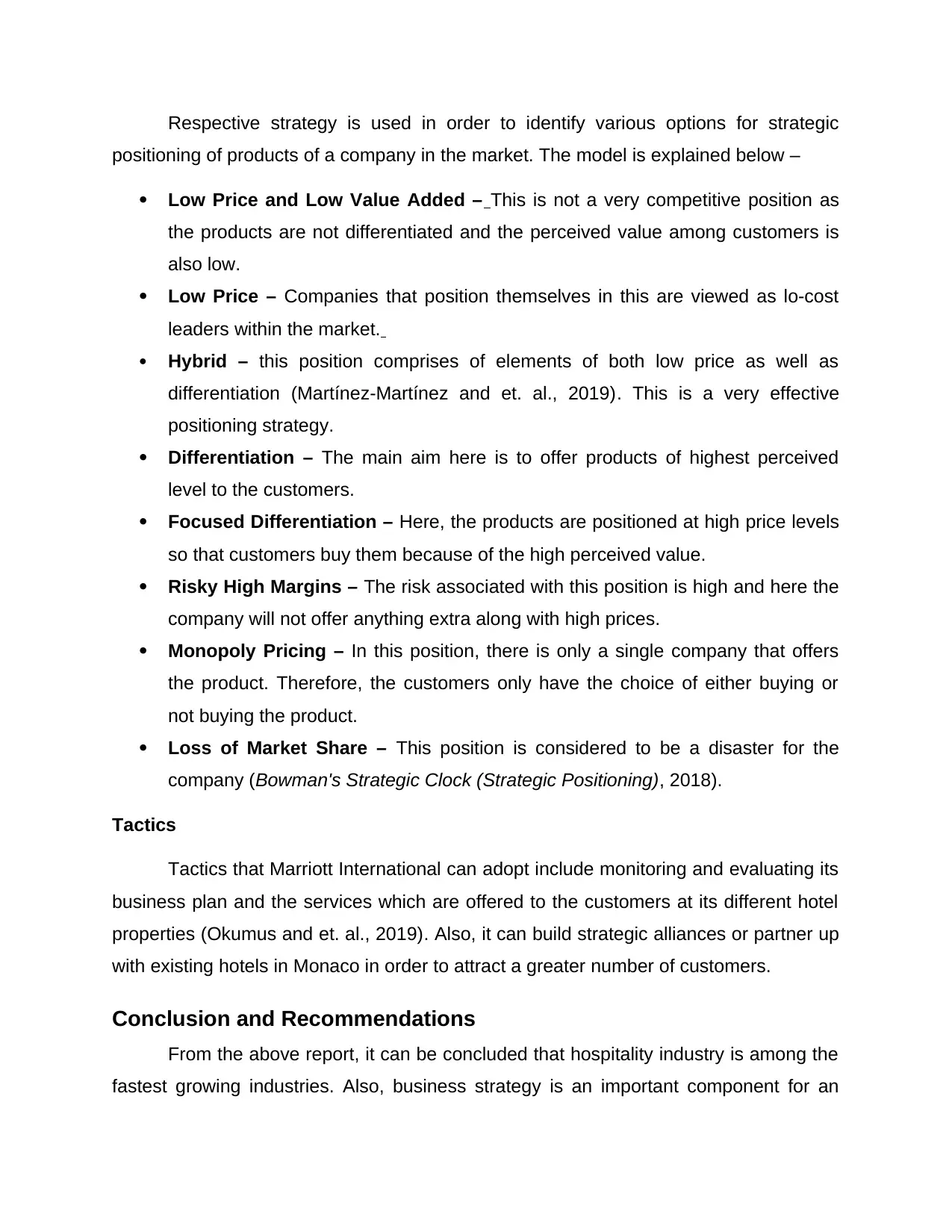
Respective strategy is used in order to identify various options for strategic
positioning of products of a company in the market. The model is explained below –
Low Price and Low Value Added – This is not a very competitive position as
the products are not differentiated and the perceived value among customers is
also low.
Low Price – Companies that position themselves in this are viewed as lo-cost
leaders within the market.
Hybrid – this position comprises of elements of both low price as well as
differentiation (Martínez-Martínez and et. al., 2019). This is a very effective
positioning strategy.
Differentiation – The main aim here is to offer products of highest perceived
level to the customers.
Focused Differentiation – Here, the products are positioned at high price levels
so that customers buy them because of the high perceived value.
Risky High Margins – The risk associated with this position is high and here the
company will not offer anything extra along with high prices.
Monopoly Pricing – In this position, there is only a single company that offers
the product. Therefore, the customers only have the choice of either buying or
not buying the product.
Loss of Market Share – This position is considered to be a disaster for the
company (Bowman's Strategic Clock (Strategic Positioning), 2018).
Tactics
Tactics that Marriott International can adopt include monitoring and evaluating its
business plan and the services which are offered to the customers at its different hotel
properties (Okumus and et. al., 2019). Also, it can build strategic alliances or partner up
with existing hotels in Monaco in order to attract a greater number of customers.
Conclusion and Recommendations
From the above report, it can be concluded that hospitality industry is among the
fastest growing industries. Also, business strategy is an important component for an
positioning of products of a company in the market. The model is explained below –
Low Price and Low Value Added – This is not a very competitive position as
the products are not differentiated and the perceived value among customers is
also low.
Low Price – Companies that position themselves in this are viewed as lo-cost
leaders within the market.
Hybrid – this position comprises of elements of both low price as well as
differentiation (Martínez-Martínez and et. al., 2019). This is a very effective
positioning strategy.
Differentiation – The main aim here is to offer products of highest perceived
level to the customers.
Focused Differentiation – Here, the products are positioned at high price levels
so that customers buy them because of the high perceived value.
Risky High Margins – The risk associated with this position is high and here the
company will not offer anything extra along with high prices.
Monopoly Pricing – In this position, there is only a single company that offers
the product. Therefore, the customers only have the choice of either buying or
not buying the product.
Loss of Market Share – This position is considered to be a disaster for the
company (Bowman's Strategic Clock (Strategic Positioning), 2018).
Tactics
Tactics that Marriott International can adopt include monitoring and evaluating its
business plan and the services which are offered to the customers at its different hotel
properties (Okumus and et. al., 2019). Also, it can build strategic alliances or partner up
with existing hotels in Monaco in order to attract a greater number of customers.
Conclusion and Recommendations
From the above report, it can be concluded that hospitality industry is among the
fastest growing industries. Also, business strategy is an important component for an
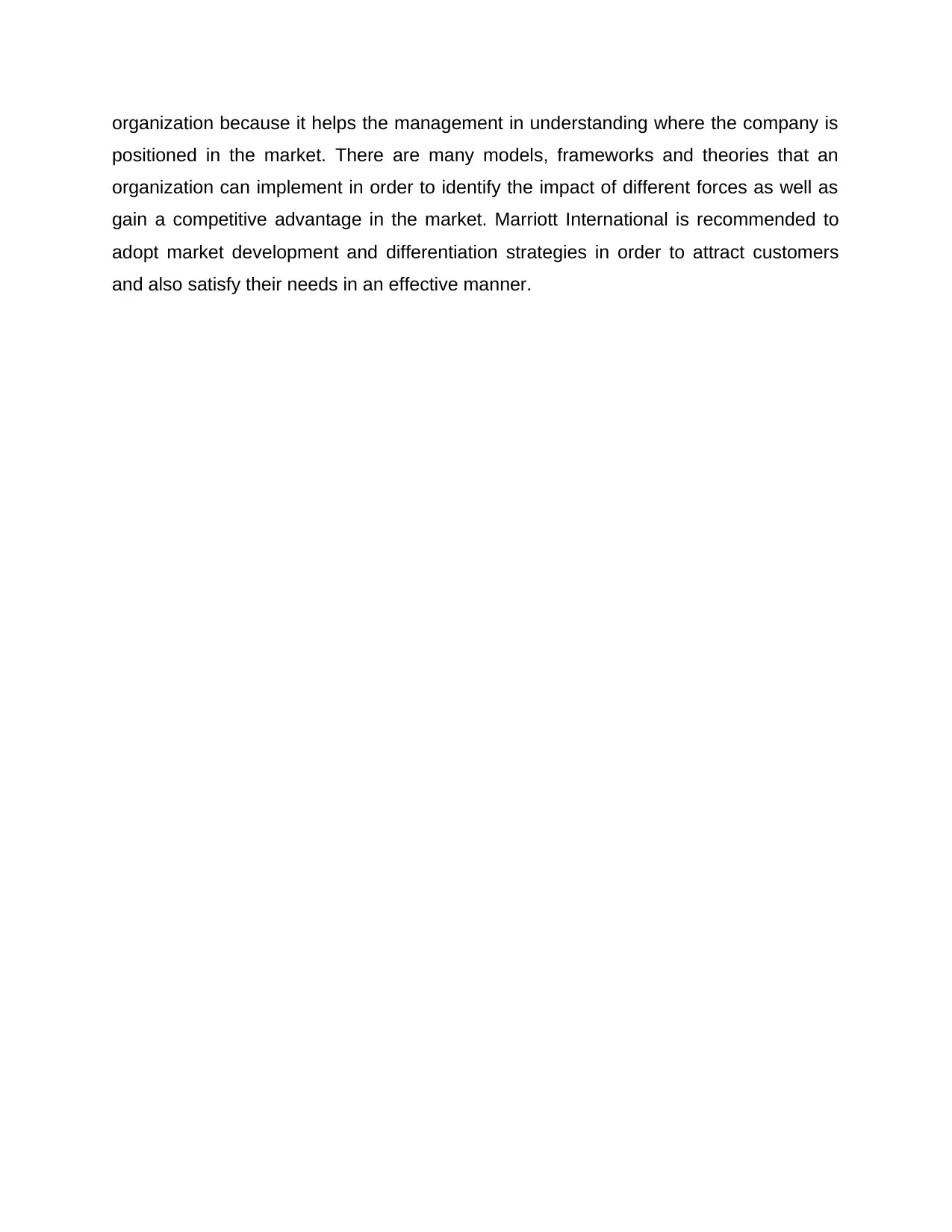
organization because it helps the management in understanding where the company is
positioned in the market. There are many models, frameworks and theories that an
organization can implement in order to identify the impact of different forces as well as
gain a competitive advantage in the market. Marriott International is recommended to
adopt market development and differentiation strategies in order to attract customers
and also satisfy their needs in an effective manner.
positioned in the market. There are many models, frameworks and theories that an
organization can implement in order to identify the impact of different forces as well as
gain a competitive advantage in the market. Marriott International is recommended to
adopt market development and differentiation strategies in order to attract customers
and also satisfy their needs in an effective manner.
Paraphrase This Document
Need a fresh take? Get an instant paraphrase of this document with our AI Paraphraser
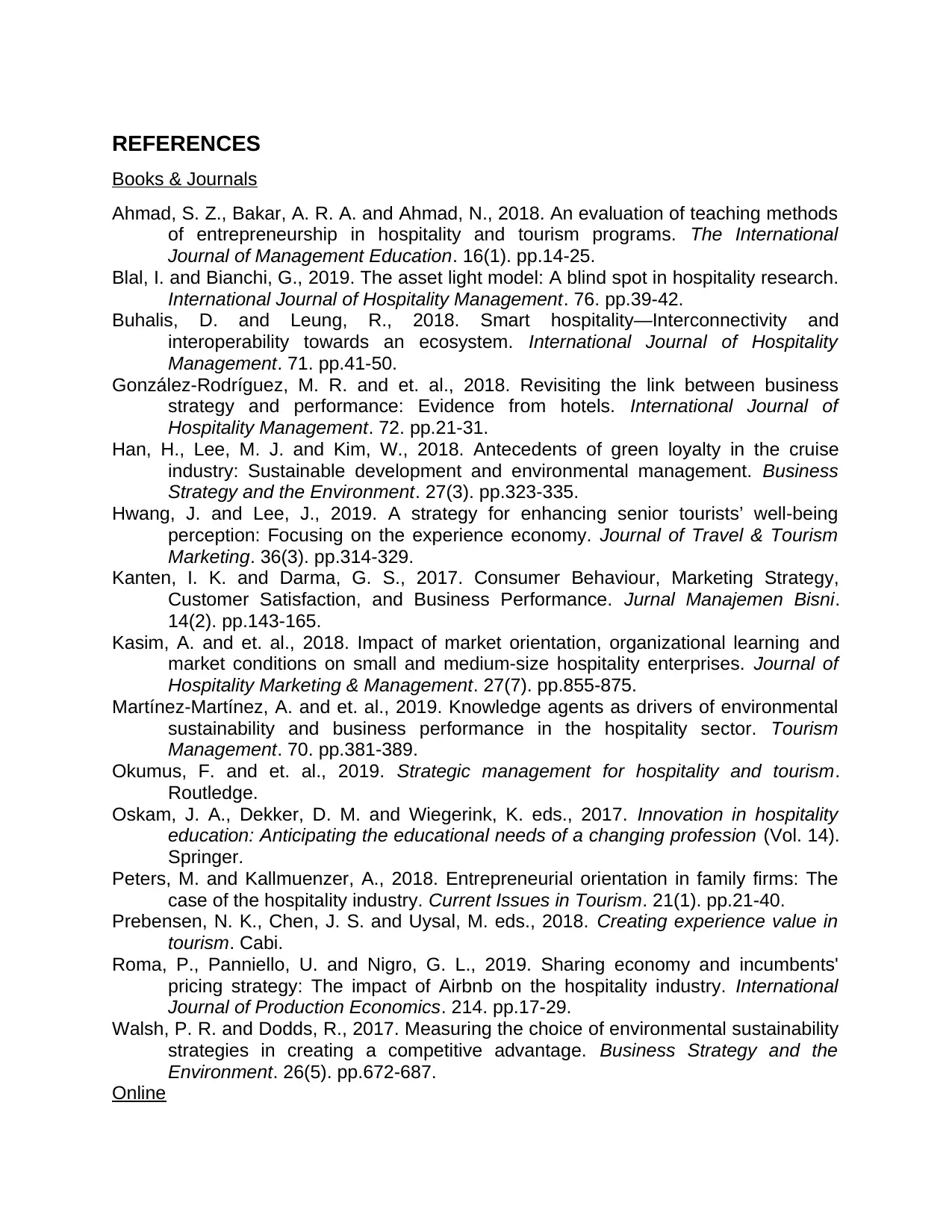
REFERENCES
Books & Journals
Ahmad, S. Z., Bakar, A. R. A. and Ahmad, N., 2018. An evaluation of teaching methods
of entrepreneurship in hospitality and tourism programs. The International
Journal of Management Education. 16(1). pp.14-25.
Blal, I. and Bianchi, G., 2019. The asset light model: A blind spot in hospitality research.
International Journal of Hospitality Management. 76. pp.39-42.
Buhalis, D. and Leung, R., 2018. Smart hospitality—Interconnectivity and
interoperability towards an ecosystem. International Journal of Hospitality
Management. 71. pp.41-50.
González-Rodríguez, M. R. and et. al., 2018. Revisiting the link between business
strategy and performance: Evidence from hotels. International Journal of
Hospitality Management. 72. pp.21-31.
Han, H., Lee, M. J. and Kim, W., 2018. Antecedents of green loyalty in the cruise
industry: Sustainable development and environmental management. Business
Strategy and the Environment. 27(3). pp.323-335.
Hwang, J. and Lee, J., 2019. A strategy for enhancing senior tourists’ well-being
perception: Focusing on the experience economy. Journal of Travel & Tourism
Marketing. 36(3). pp.314-329.
Kanten, I. K. and Darma, G. S., 2017. Consumer Behaviour, Marketing Strategy,
Customer Satisfaction, and Business Performance. Jurnal Manajemen Bisni.
14(2). pp.143-165.
Kasim, A. and et. al., 2018. Impact of market orientation, organizational learning and
market conditions on small and medium-size hospitality enterprises. Journal of
Hospitality Marketing & Management. 27(7). pp.855-875.
Martínez-Martínez, A. and et. al., 2019. Knowledge agents as drivers of environmental
sustainability and business performance in the hospitality sector. Tourism
Management. 70. pp.381-389.
Okumus, F. and et. al., 2019. Strategic management for hospitality and tourism.
Routledge.
Oskam, J. A., Dekker, D. M. and Wiegerink, K. eds., 2017. Innovation in hospitality
education: Anticipating the educational needs of a changing profession (Vol. 14).
Springer.
Peters, M. and Kallmuenzer, A., 2018. Entrepreneurial orientation in family firms: The
case of the hospitality industry. Current Issues in Tourism. 21(1). pp.21-40.
Prebensen, N. K., Chen, J. S. and Uysal, M. eds., 2018. Creating experience value in
tourism. Cabi.
Roma, P., Panniello, U. and Nigro, G. L., 2019. Sharing economy and incumbents'
pricing strategy: The impact of Airbnb on the hospitality industry. International
Journal of Production Economics. 214. pp.17-29.
Walsh, P. R. and Dodds, R., 2017. Measuring the choice of environmental sustainability
strategies in creating a competitive advantage. Business Strategy and the
Environment. 26(5). pp.672-687.
Online
Books & Journals
Ahmad, S. Z., Bakar, A. R. A. and Ahmad, N., 2018. An evaluation of teaching methods
of entrepreneurship in hospitality and tourism programs. The International
Journal of Management Education. 16(1). pp.14-25.
Blal, I. and Bianchi, G., 2019. The asset light model: A blind spot in hospitality research.
International Journal of Hospitality Management. 76. pp.39-42.
Buhalis, D. and Leung, R., 2018. Smart hospitality—Interconnectivity and
interoperability towards an ecosystem. International Journal of Hospitality
Management. 71. pp.41-50.
González-Rodríguez, M. R. and et. al., 2018. Revisiting the link between business
strategy and performance: Evidence from hotels. International Journal of
Hospitality Management. 72. pp.21-31.
Han, H., Lee, M. J. and Kim, W., 2018. Antecedents of green loyalty in the cruise
industry: Sustainable development and environmental management. Business
Strategy and the Environment. 27(3). pp.323-335.
Hwang, J. and Lee, J., 2019. A strategy for enhancing senior tourists’ well-being
perception: Focusing on the experience economy. Journal of Travel & Tourism
Marketing. 36(3). pp.314-329.
Kanten, I. K. and Darma, G. S., 2017. Consumer Behaviour, Marketing Strategy,
Customer Satisfaction, and Business Performance. Jurnal Manajemen Bisni.
14(2). pp.143-165.
Kasim, A. and et. al., 2018. Impact of market orientation, organizational learning and
market conditions on small and medium-size hospitality enterprises. Journal of
Hospitality Marketing & Management. 27(7). pp.855-875.
Martínez-Martínez, A. and et. al., 2019. Knowledge agents as drivers of environmental
sustainability and business performance in the hospitality sector. Tourism
Management. 70. pp.381-389.
Okumus, F. and et. al., 2019. Strategic management for hospitality and tourism.
Routledge.
Oskam, J. A., Dekker, D. M. and Wiegerink, K. eds., 2017. Innovation in hospitality
education: Anticipating the educational needs of a changing profession (Vol. 14).
Springer.
Peters, M. and Kallmuenzer, A., 2018. Entrepreneurial orientation in family firms: The
case of the hospitality industry. Current Issues in Tourism. 21(1). pp.21-40.
Prebensen, N. K., Chen, J. S. and Uysal, M. eds., 2018. Creating experience value in
tourism. Cabi.
Roma, P., Panniello, U. and Nigro, G. L., 2019. Sharing economy and incumbents'
pricing strategy: The impact of Airbnb on the hospitality industry. International
Journal of Production Economics. 214. pp.17-29.
Walsh, P. R. and Dodds, R., 2017. Measuring the choice of environmental sustainability
strategies in creating a competitive advantage. Business Strategy and the
Environment. 26(5). pp.672-687.
Online
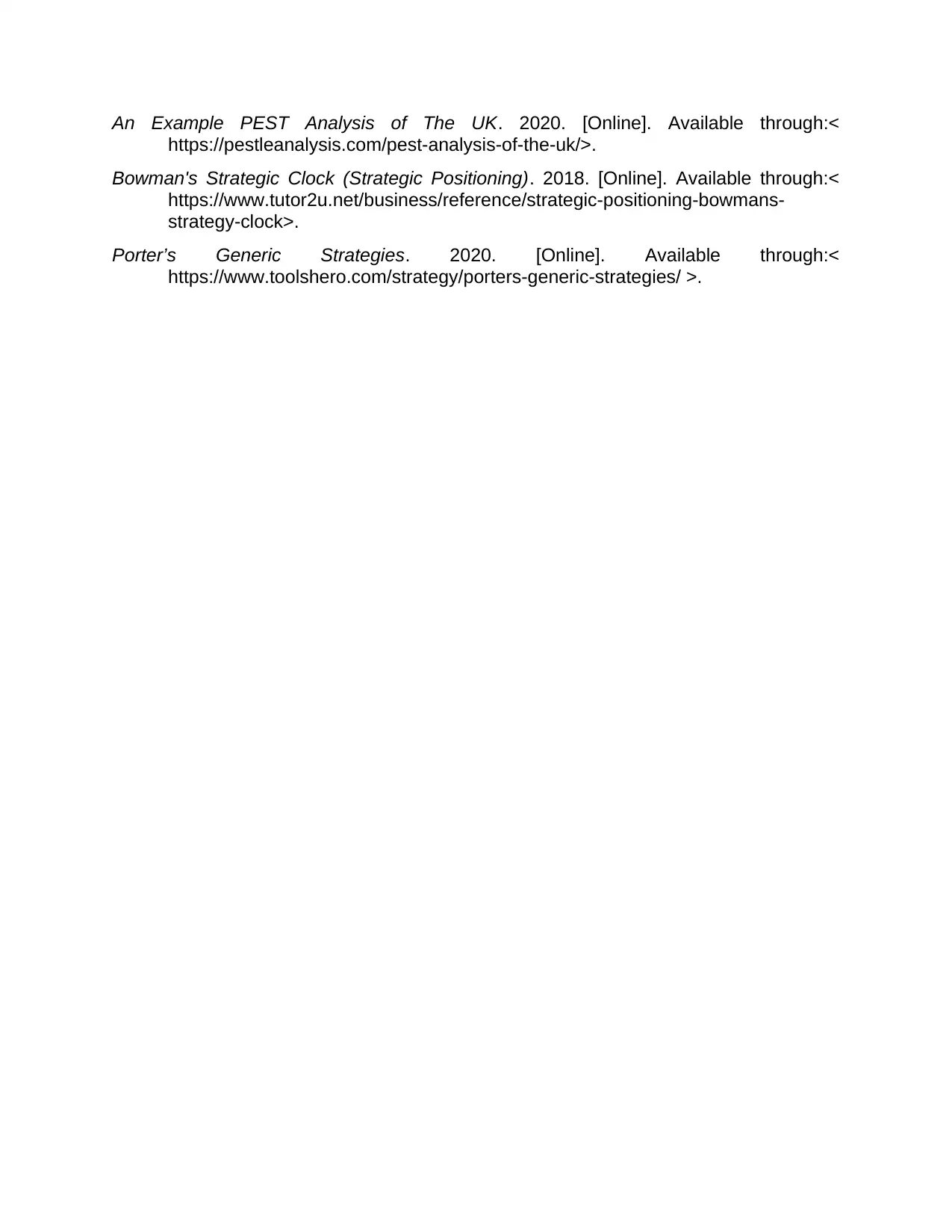
An Example PEST Analysis of The UK. 2020. [Online]. Available through:<
https://pestleanalysis.com/pest-analysis-of-the-uk/>.
Bowman's Strategic Clock (Strategic Positioning). 2018. [Online]. Available through:<
https://www.tutor2u.net/business/reference/strategic-positioning-bowmans-
strategy-clock>.
Porter’s Generic Strategies. 2020. [Online]. Available through:<
https://www.toolshero.com/strategy/porters-generic-strategies/ >.
https://pestleanalysis.com/pest-analysis-of-the-uk/>.
Bowman's Strategic Clock (Strategic Positioning). 2018. [Online]. Available through:<
https://www.tutor2u.net/business/reference/strategic-positioning-bowmans-
strategy-clock>.
Porter’s Generic Strategies. 2020. [Online]. Available through:<
https://www.toolshero.com/strategy/porters-generic-strategies/ >.
1 out of 15
Related Documents
Your All-in-One AI-Powered Toolkit for Academic Success.
+13062052269
info@desklib.com
Available 24*7 on WhatsApp / Email
![[object Object]](/_next/static/media/star-bottom.7253800d.svg)
Unlock your academic potential
© 2024 | Zucol Services PVT LTD | All rights reserved.





